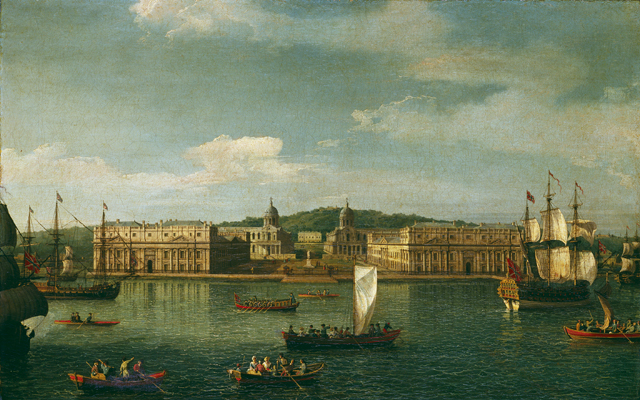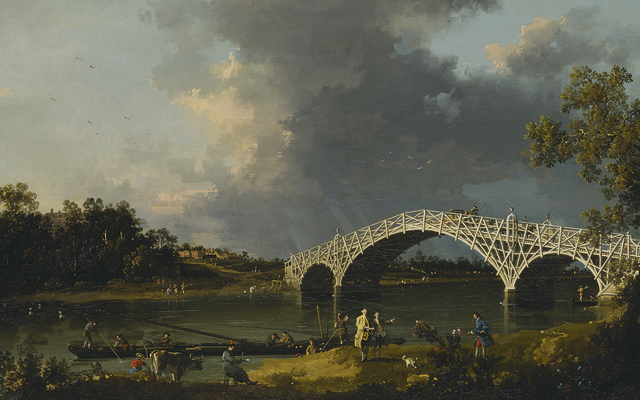Exhibition review: ‘Canaletto: Celebrating Britain’ at Compton Verney
Huon Mallalieu admires Canaletto’s paintings of English subjects.

During the 1730s and early 1740s, no British Grand Tourist could return from Venice without his pair of Canalettos, just as, slightly later, he could not visit Rome without sitting to Batoni.
The milordi were by no means the only patrons of these artists, but they were highly important in establishing their reputations above those of other view and face painters.
As the historian Sir John Plumb warned: ‘It should never be forgotten that the 18th century Englishman was rich rather than cultured…cherishing an excessive respect both for the art of France and Italy and for the glories of Greece and Rome.’ As a result, more Canalettos (and Poussins) came to England than anywhere else.
Giovanni Antonio Canal, ‘il Canaletto’ (1697–1768) is admired again nowadays, but it was not always so. In 1866, Richard and Samuel Redgrave could write in Little Englander vein of his arrival in London: ‘The works and reputation of this Italian had preceded him; the facility and apparent certainty of his execution, and even the mechanical methods of handling displayed in his works, had a charm for those who had been accustomed to the tiresome excellence of the Dutch School.’
They deplored his influence—‘many of his mechanical modes of imitating Nature were adopted by our landscape painters of the period’.

That influence was due not so much to his Venetian views as to the English subjects that he produced while living in what is now Beak Street, Soho, between 1746 and 1755. From 1740, the Continent was engulfed by the War of the Austrian Succession, and the lucrative flow of milordi to Italy stopped. The Venetian Republic’s long decline accelerated and artists left to pursue careers abroad.
London was a natural destination for Canaletto, encouraged by such patrons as Sir Hugh Smithson, soon to be Earl and later Duke of Northumberland, not only because he was already well known there, but chiefly because it was rapidly becoming the greatest city in the world.
Exquisite houses, the beauty of Nature, and how to get the most from your life, straight to your inbox.
Between the Treaty of Utrecht and the failure of the 1715 rebellion, and the War of Jenkins’ Ear with Spain from 1739, Britain had experienced an unusual period of tranquillity under the somnolent regime of Sir Robert Walpole (later 1st Earl of Orford). As a result, the building boom that had begun with the Restoration and the Fire of London was fuelled by prosperity.
As Steven Parissien, curator of the exhibition at Compton Verney, and his fellow writers in the accompanying publication, Celebrating Britain: Canaletto, Hogarth and Patriotism, emphasise, the majority of Canaletto’s English works were intended to celebrate the latest achievements of British architecture, including seeming anomalies as Warwick Castle, recently modernised, or Hawksmoor’s new Gothic towers for Westminster Abbey. When older structures, such as the Old Horse Guards or Old London Bridge, take centre stage, it is because they were about to disappear.
Canaletto must have questioned his wisdom in coming to London when the city, and his patrons, had so recently been threatened by the Jacobite army, but with the retreat from Derby, Culloden and the 1748 Peace of Aix-la-Chapelle, his career resumed its prosperous course.

It was natural that a Venetian should be most at home by the river and one of Canaletto’s principal subjects was Westminster Bridge, built between 1739 and 1750 and regarded by many as the engineering triumph of the age. Batty Langley wrote against it, but his own design had been rejected in favour of that of the naturalised Swiss Charles Labelye.
The Gentleman’s Magazine was more positive, seeing it ‘a very great ornament to our metropolis, and will be looked on with pleasure or envy by all foreigners. The surprising echo in the arches brings much company with French horns to entertain themselves under it in summer; and with the upper part, for an agreeable airing, none of the publick walks or gardens can stand in competition’.
It was Canaletto’s task, on behalf of promoters including Northumberland, to ensure that all foreigners should know of it. One of his innovative tricks, much imitated by future generations, was the viewpoint from beneath one of the acoustic arches, using it to frame St Paul’s and the new City churches. Perhaps even more than in Venetian views, he gives an illusion of an exact record, while playing with his subjects.
He was happy to alter even so well known a structure as the cathedral when it suited him. As Michael Levey put it, Canaletto’s London is ‘as clean and neat as a town embedded in a glass paperweight: and as hard, clear and miniature—and distant’.
The show, which goes on to The Holburne Museum in Bath in June and Abbot Hall Art Gallery in Kendal, Cumbria, in October, also shows that the best of Canaletto’s British competitors, notably William Marlow and Samuel Scott, were no mere imitators.
'Canaletto: Celebrating Britain' is at Compton Verney, Warwickshire, until June 7 (01926 645 500; www.comptonverney.org.uk)
Huon Mallaleiu writes on fine art and antiques for Country Life magazine